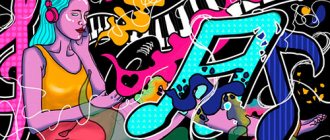A person perceives information through the main five channels: visual, auditory, tactile, gustatory, olfactory. And after perception, the information is processed in our head, and the interesting thing is that it is processed on the basis of one prevailing system .
There are four main types of sensory systems:
- Visual. When the visual information processing system is dominant: shape, location, color.
- Auditory. The auditory information processing system is dominant: sounds, melodies, their tone, volume, timbre, purity
- Kinesthetic. Sensory information is dominant: touch, taste, smell, sensation of textures, temperature
- Digital. Associated with the logical construction of internal dialogue.
One should not think that the dominance of one means the weakness of the other. It’s just that one of the systems is most often the starting, leading one. It is the leading system that launches the thinking process and becomes the impetus for other mental processes: memory, representation, imagination.
How can you determine who you are: visual, auditory, kinaesthetic or digital by speech?
Carefully monitor your speech and write down exactly the phrases that you use to indicate your opinion and your actions. Most often, a person of a particular type of perception uses phrases characteristic of this modality.
Visual
Uses words and phrases related to visual actions : I didn't see, I saw, I noticed, I think it was colorful and great, it looks, focus is concentrated, contrast, perspective, you see.
Audial
They often use phrases with auditory phrases : I can’t understand what you’re saying; didn't hear; I heard it; I recently heard; glad to hear from you; I heard it; the idea sounds tempting.
Kinesthetic
This type of perception is characterized by phrases that show their emotional and bodily responses: I can’t stand it; it's disgusting; it is so sweet; goosebumps; so pleasantly warm; it was a powerful experience. Often their nonverbal signs are very indicative; facial expressions and gestures are telling and reflect the state and emotions of a person, even if there are not many nonverbal signs themselves.
Digital
Digitals pay attention to logic and connections. A specific set of words is not typical for them: phrases of auditory and kinesthetic types may appear. Digital people often ask: what is the point of this; I don’t understand how this is connected; I would like to bring everything into a system; we need to streamline this somehow. However, such expressions are typical of most types with a good sense of organization. Therefore, identifying digital from speech must be done with great care.
Each type has its own characteristics that affect its perception of surrounding information, any educational processes, and interaction with other people. Let us analyze the characteristics of people of different types of perception.
Who is a visual
A visual person is a psychotype of a person who prefers to get acquainted with the world around him through visual receptors and attaches great importance to the appearance of a phenomenon (Efremova’s explanatory dictionary).
Visual is a type of information perception. People imagine the world through visual images, which means they easily describe what they see and are amazing storytellers. Visual people will not miss the opportunity to daydream, but at the same time they know how to clearly build strategies and plans of action, and not indulge in empty pastime.
Professions suitable for visual people
One of the main conditions for a happy life is rightfully considered to be a favorite activity, for which a person has inclinations and abilities. Visuals are distinguished by excellent visual memory, as well as a rather specific and original manner of perceiving information; these qualities can be applied in various spheres of human life.
A visual artist can make an excellent artist, photographer, colorist, fashion designer, architect, designer, painter, costume designer and interior designer. Many visual people have a penchant for the humanities and are capable of becoming good specialists in the field of psychology and sociology; in addition, people belonging to the described psychotype make qualified and capable teachers and lecturers.
How to recognize a visual person - appearance
It is quite difficult to confuse a visual person with another type of perception. First of all, you should pay attention to the person’s appearance.
| Characteristic. | An example from life. |
| Beautiful, stylish, tastefully selected clothes. | Visual people care about appearance, so they choose only beautiful clothes and shoes. Often their clothes are uncomfortable and impractical, but they look very advantageous. Visual artists cleverly emphasize the advantages of their figure and also skillfully hide their shortcomings. |
| Accuracy in everything. | The hair is styled perfectly, the makeup is neat, there are no stains, dust particles or folds on the clothes, the shoes are polished to a shine. The visual worker has perfect order in his workplace. |
| Straight posture. | Even if the visual is tired, has experienced stress or a hard work shift, his posture is straight and he will not allow himself to hunch over. |
| Expressive facial expressions and gestures. | Their eyes are open wide, their facial expressions are very bright, their gestures are appropriate and energetic. Any actor or comedian would envy such abilities. |
| The ability to tell stories. | Visual learners are considered the best and most interesting storytellers, since they constantly keep a picture of what is happening before their eyes and are able to describe it. |
| The importance of the interlocutor. | It is important for visual learners what the interlocutor thinks about them, therefore, during the process of telling a story, they constantly look up at him and try to see approval and a positive mood in the person’s facial expressions. |
Not everyone has time to take care of their appearance, and some shortcomings can spoil the mood and constrain them. And this will be noticeable; the person may be tense.
Are there any disadvantages to visual learners?
Being too focused on the “cover” often plays a cruel joke on visual learners who may underestimate the “content.” A striking example is relationships with a partner. Man, although he has risen above other animals, has not lost touch with his biological nature. He is still dependent on the endless biochemical reactions occurring every second in his body. Love also relies on hormones. This is why your partner's scent is so important.
Two equally attractive girls can evoke different attractions due to differences in pheromones, which a kinesthetic person will definitely smell. And if they both open their mouths, then the auditory audience will definitely understand with whom it is better to conduct a dialogue. The discrete sums everything up logically. What about the visual? He will simply choose the most beautiful one, even if it doesn’t have the right scent or erudition. This is the great danger of being too focused on one analyzer. But pure psychotypes are not common, so visualists can simultaneously, albeit to a lesser extent, assess the situation with the help of other senses and even logic.
Psychological picture
Visual people also have psychological characteristics and habits that distinguish them from other people:
- They can become so focused on the appearance of the interlocutor that they completely forget the essence of the conversation.
- During a conversation with a person, the visual person tries to position himself opposite him so that he can look into the person’s eyes. But the visual will not violate someone else's personal space.
- Word forms such as “I saw”, “Look” and similar ones are often used in speech.
- They avoid telephone calls, as it is important for them to see the other person. During video calls, a camera is always used.
- They easily remember a person’s appearance and details of his clothing, but forget other important information (name, surname, position, essence of the issue).
- Often cannot sit still, looking at one point. The visual person constantly needs new visual impressions and objects to look at.
- When listening to a text or a story about any life situation, the visual reader involuntarily imagines it.
- When arranging a house, apartment or workplace, visual gives preference to external attractiveness. You can find a lot of beautiful, but useless things in everyday life.
- They often find fault with little things. For example, if you serve a visual person an exquisite dish on an ugly, shabby plate, he will refuse to eat. But if you offer the most ordinary porridge in a beautiful bowl, he will accept the treat with pleasure.
- The easiest way to recognize a visual student among students or schoolchildren is to just look at their notes. Visuals do not write “on canvas”; information is recorded in the form of plates, diagrams, graphs, definitions and terms are highlighted in a different color.
Are there any visual people among your friends? How do they behave? Tell us about it in the comments.
Visual, auditory, kinesthetic, digital in the learning process
If you study a lot, go to courses, trainings, read, then understanding your own type of perception will help you organize your own learning process with maximum benefit.
Visuals
The basis of their learning is visual information. For visual people, hearing and vision form a single whole, therefore, if such a person only heard the material (but did not see), then with a high degree of probability the information will be quickly forgotten. Visual learners instantly absorb all visual information, so it is most beneficial to use all methods and techniques for visually presenting the material:
- mind maps
- scheme
- graphs
- illustrations
- photos
- demonstration models
- experiments, experiments
Visual learners learn best through visual examples, where they see the material they are learning in real time. Primary memory is visual. They remember well the location of objects, paths, roads, and are well oriented in space. Some noise is not critical for a visual learner; he can concentrate in an environment of some noise and successfully study the material.
Visual learners perceive text information well and are able to quickly learn speed reading.
Audial
Uses the auditory perception channel as a trigger. Inner speech is moderately developed. They perceive lectures, music, conversations, and dialogues well. They clearly and effectively maintain the line of conversation and conversation; often it is during the conversation that they grasp the meaning of the material being studied. Silence is necessary when concentrating. If you are an auditory learner, then be sure to listen to lecture material and audio courses. Learn together with others, discussing the topic being studied, thinking out loud about the problem.
Kinesthetic
Receives information through actions and movements. He remembers any actions and practical exercises well. He perceives all information best through practical exercises and experiments, where he tests the information received with his own hands in practice. Information of a practical nature is especially well perceived: what moves and how, where to click.
It is important for kinaesthetic learners to feel, touch, smell, taste and fully experience the subject being studied. People of this type are very active, love and enjoy working. And they don’t like inaction. It is for kinesthetic learners that the saying “Movement is life” has a special meaning. It is very difficult for kinaesthetic people to maintain focus, they are easily distracted, it is difficult for them to sit still for a long time, or to do routine work.
Digital
They are well trained in all sciences that have strict logic and consistency: mathematics, physics, mechanics, technology. Such people often work in areas where there is a lot of research, mathematical and static processing, and programming. The main thing for digital is to understand the logic and connections in the material, to organize what is being studied into a system with clear cause-and-effect relationships. Therefore, during your studies, try to build the logic of the entire topic being studied. For this you can use:
- scheme
- mind maps
- compressed plans
- Personally compiled thesauri
What benefits can you get for yourself - the advantages of the type
Visual learners are often successful academically and professionally because they can:
remember large amounts of information, using visual memory (an invaluable quality if you need to prepare for a session or certification at work);
skillfully navigate the area, armed with a map or electronic application, they will not get lost even in an unfamiliar city, and will quickly find the desired object or organization;
are able to understand drawings, complex diagrams and diagrams;
if desired, thanks to their rich imagination, they can develop artistic skills and learn to draw well, because a visual person sees the world in artistic images;
Their aesthetic taste and impeccable appearance can be envied, so the visual is in the spotlight.
Auditory, visual, digital and kinesthetic
Each person is an individual person who perceives the outside world differently.
- Someone listens to every word, timbre of voice, and perceives information better by ear. This is audio .
- Some people focus on color, shape, appearance. Such people are called visuals .
- A digital person is a person who primarily perceives the world through logical thinking, paying less attention to perception through analyzers (eyes, ears, hands).
- A kinesthetic person is a person who perceives the world by touch, tactilely.
In addition to the specifics of the main channel through which information is received, auditory, visual and kinesthetic learners differ from each other, for example, in the method of learning that must be used for an effective result, and in their manner of behavior.
Work and profession
Visual people can try their hand at activities.
| Profession. | Why is it suitable for visual learners? |
| Architect. | Thanks to his exquisite taste and ability to understand complex diagrams and drawings, a specialist will be able to show his best side. |
| Fashion designer, stylist. | If a person knows how to see beauty and wants to create it himself, then he deserves to become a fashion designer. And for those who do not have enough skills and imagination to create their own clothing line, you can select ready-made sets while working as a stylist. |
| Colorist. | A very popular specialty for people with color vision. |
| Painter. | If you are a visual artist and don’t want to spend a lot of time on training, then you should try yourself as a painter, because not everyone can become a good painter. And in the future, after gaining experience, the painter can retrain as a decorator. |
| Animator. | The ability to imagine details and a well-developed imagination will help a visual artist become a cartoonist. |
| Photographer, designer of social network pages. | A visual photographer will be able to see beauty and capture moments in time. Nowadays, creating a “visual” for a social network page and designing an eternal feed on Instagram are in demand. |
| Technical specialties. | A visual person with a less developed sense of beauty can try to become a designer, technician or engineer; the ability to keep a large amount of information in his head and work with drawings will only benefit him. |
| Interior designer. | Another specialization option for people with a developed aesthetic sense. |
| Beauty master. | A visual artist can also find himself in the profession of a hairdresser, creating beautiful haircuts, hairstyles or fashionable color dyeing. Nail specialists, pedicurists, eyelash extension specialists, and makeup artists are in great demand. |
Work for the visual
The skill of thinking in images and vivid pictures finds its application in a variety of creative fields. The professions of photographer, designer, illustrator, artist, constructor, fashion designer, stylist, sculptor are suitable for visual people. He can spend hours contemplating various phenomena, objects, or other people, making sketches of them. This psychotype is characterized by a desire for beauty and harmony. Unlike connoisseurs of convenience - kinesthetics, visual learners prefer trends. It is thanks to their efforts that fashion is constantly changing, with some styles and palettes being replaced by others.
In the era of rapid development of social networks and widespread blogging, visuals have gained new power. The entire industry built around Facebook, Instagram, YouTube or TikTok is aimed at beautiful pictures or spectacular videos. The bulk of SMM specialists are most likely from the fraternity of visualists. Although, analytical thinking in this area is also necessary, especially when it comes to targeted advertising, selection of target audiences, and further interpretation of statistical data. Discretionaries excel at this. But pure psychotypes are not so common. So, effective SMM workers are visual people with a slight touch of “discreteness”.
The gaming industry and cinema are no less connected with visual perception. Beautiful, bright, rich images of the main characters or villains are created by people with imagination. Iconic characters like Jack Sparrow, Master Yoda, Shao Kahn, Shredder or even Pikachu, appeared precisely thanks to the developed imagination of their creators. It is difficult to say what the world would play or what films it would watch if there were only auditory, discrete and kinesthetic learners on our planet.
Relationships with the visual
When building a romantic relationship with a visual person, it is important to remember the details. Visual people evaluate the image of the other half, but one detail can ruin the whole impression.
For example, if a girl came on a date with makeup, hairstyle, stylish clothes and shoes, but the visual guy noticed a stale, month-old manicure, then this can really ruin the impression. Likewise, a visual girl will be able to draw disappointing conclusions about her partner if his home is a mess, mountains of crumbs and unwashed dishes. On this basis, the couple may begin to quarrel and misunderstandings may arise.
The possibility of such situations should be taken into account. There is no need to try to adapt to the visual every second. If you feel tension in communication, you should talk frankly and discuss everything.
When building a relationship with a visual person, it is important to remember that touches, hugs and beautiful words are not particularly important to him. The best expression of love is giving aesthetically pleasing gifts.
When communicating, you need to use short and concise phrases, and understand once and for all that visual people do not understand hints. They need to speak directly about their desires.
In family life with a visual person, you need to be prepared for the fact that intimacy is a rare occurrence. It is much more pleasant for a visual person to walk around the city, and if his partner offers him a weekend trip, then the visual person will be happy.
Have you ever built a relationship with a visual person? Are there life hacks for successful communication in marriage? Tell us about your experience in the comments.
How to communicate correctly with a visual person
You can establish interesting communication with a visual person, because he is an excellent conversationalist and a sincere storyteller, the only important thing is:
- Learn to maintain eye contact with a visual person.
- If there is a need to prove something to a visual person or teach something, then you need to use visual examples, images and materials.
- Statistics, “dry” and boring facts and similar information are best presented in the form of tables, diagrams, diagrams.
- If a person wants to impress a visual boss at an interview or conclude a profitable deal with a visual person, then they will have to take care of their appearance very carefully.
- Maintain a distance of 1-1.5 meters, do not violate a person’s personal space.
Visual child - features of education and training
If parents understand that their child is a visual learner, then it is necessary:
- Broadcast only the correct model of behavior from a moral and social point of view. Don't forget that visual learners are observant. If a child sees that his parents, for example, teach him to always clean up after himself, but do not do this themselves, then the educational process will not be successful.
- Cultivate tact and politeness in your child. As a rule, visual people are fixated on their own and others' appearance. It is important to stop your child’s attempts to speak disrespectfully about people who are dressed sloppy or dirty.
- A child’s fixation on appearance can develop into narcissism, so it is important to unobtrusively switch his attention to other activities, games, and entertainment.
- Children with a visual personality type are often addicted to computer games and gadgets. It is important to prevent your hobby from developing into Internet addiction. As an alternative, you can offer crosswords, puzzles, coloring books, paint-by-number paintings, and other creativity kits.
When parents help a child do his homework or teachers engage in educational activities with him, it is important to provide them with visual materials and aids (accompanying illustrations, signs, diagrams). This will help the visual learner to better assimilate the material.
Simply talking about the phenomenon being studied will not be enough. Illustrations and visual materials are a mandatory minimum, but if the teacher has the opportunity to include educational films, demonstrate experiments or simulate situations, then visual learners will learn the material much better.
What difficulties might parents of a visual teenager encounter?
In adolescence, visual children have a hard time experiencing imperfections in their own appearance (teenage acne, weight fluctuations, awkwardness, unformed figures in places). It is important for parents to provide the child with the necessary support and under no circumstances make fun of him, even in a loving and kind manner.
What should a teacher do if a visual student is often distracted in class?
Visual children are often distracted by external stimuli. There is no point in removing them, because the child may simply begin to dream and fantasize in his head. The teacher’s goal is to teach the material in a very lively and interesting way, often change the type of activity the child is doing, and involve him as much as possible in the process of learning new things (offering days of self-government, allowing the student to explain something new to the class, giving creative tasks).
How to find an approach to a visual client
If a person has a need to collaborate with a visual client, then he will need to take into account:
- There is no need to rush the client. To make a final decision on purchase, contract or lease, a person needs to carefully examine and think about everything.
- If a person frowns, hunches over, or stands in a closed position, this can scare away the visual client. It is better to smile, behave kindly, and make eye contact.
- Visuals pay great attention to packaging, so it should be designed creatively.
- It is difficult for a visual person to perceive information by ear; it is better to immediately prepare a printed version for him.
Features of each type of perception
Visuals
The peculiarity of this type of people is that they are receptive to what is visible. They appreciate beauty in the surrounding space and do not tolerate disorder or dirt well. In the life of a visual person there are many ideas, dreams, dreams. They are often generators of ideas, since they can create completely unusual associations and connections in their imagination.
Audial
They perceive the world around them, paying especially close attention to sounds. They love music, melodies, and can often hum to themselves and hum songs. Sensitive and receptive to conversations, auditory people have acute hearing and good memory, especially auditory memory. They often choose as their occupation everything related to music, melodies, and oratory.
Kinesthetic
Kinesthetics are very sensitive to everything that happens around them. Their bodily and emotional sensations are closely intertwined. They love bodily comfort, the convenience of the surrounding space. Uncomfortable clothing or a thread tickling their neck can irritate a kinaesthete student. They love deep personal discussions, communication with emotional exchange, discussion of how others feel. For the kinesthete, touch has the deepest meaning and great value.
Digital
People of this type of perception are rarer. They tend to perceive the world around them through inner speech, through dialogue with themselves. Such people are primarily focused on the perception of meaning, logic, and consistency. Digital people always strive to understand and comprehend the essence of what is happening. They may be sensitive and vulnerable, but the world is interesting to them from the point of view of understanding meaning and logic, patterns. In a stressful situation, it is digitals that best maintain composure and calm, and can maintain clarity of thought and perception of the surrounding space.
Strictly speaking, the distribution of people into visual, auditory, kinaesthetic, and digital types is very simplified. In fact, each of these types can be mixed, or maybe with a different leading hemispheric system, which increases the number of options. But we'll talk about this later.
Of course, in each of us there is no pure one type of perception, sometimes they are mixed, sometimes the type of perception is different in a calm and emergency environment, in different situations. But understanding your leading system will allow you to better assimilate any information, understand your interlocutor and better convey your thoughts to him. Understanding your type of perception (visual, auditory, kinesthetic, digital) will allow you to understand how to study specifically for you, taking into account your individual characteristics.
Visual appearance
People with a predominance of the visual channel of perception pay a lot of attention to their own appearance. As a rule, they have an ectomorphic body type. Their shoulders are always straight and their back is straight.
A person with a visual type of perception is always neat, combed and clean-shaven. If auditory learners value melody and pleasant sounds, then visual learners appreciate beautiful images, so the image of a person with a predominant visual way of perceiving information is thought out to the smallest detail. They buy high-quality branded items and treat them very carefully. They know how to combine wardrobe items and select accessories to go with them.
If you have to choose between beauty and comfort in clothing, the visual will certainly choose beauty. Thus, digital women are more likely to buy ballet flats or clogs for the summer, and visual girls will choose stiletto sandals.
A girl with a visual way of perceiving information can twirl in front of the mirror for several hours, doing perfect makeup and an impeccable hairstyle. Such a lady's manicure is always in order.
Appearance of a visual girl
By placing increased demands on his own appearance, the visual artist demands the same from those around him. He will certainly point out to his friend a stain on his shirt, and will not hesitate to straighten his interlocutor’s collar.
How to determine the dominant type of perception by speech
Dominant channels of perception contribute to better assimilation of information in a form convenient for humans. Psychologists are convinced that the predominant type of perception of an individual can be determined by his speech.
So, a person who has auditory perception loves to communicate. His statements are long and pithy. The speech of such people is loud, emotional and clear. When expressing emotions, auditory learners often cry out and use interjections. Sometimes they talk to themselves or hum softly. During a conversation, the auditory learner tries not to look at the interlocutor (this makes it easier for him to concentrate on what he hears).
Visual people in their everyday vocabulary use expressions such as “this looks unusual”, “this is an obvious fact”, “just imagine”, “let’s look at the situation from the other side”, “performed brilliantly”. The visual's speech is full of gestures, and his statements are accompanied by rich facial expressions. During telephone conversations, a visual person often draws fancy patterns and symbols on some piece of paper, which makes it easier for them to assimilate the information they hear.
In dialogues, the kinesthetic person often says “I feel a cooling sensation,” “it seems to worry you,” “I had a premonition.” Perceiving information from the outside world through the skin allows kinaesthetes to be the first to sense that the room is too stuffy or too cold.
A person whose digital channel dominates tends to question everything when communicating with friends and demand proof of certain statements. When expressing his position, he often refers to the theories and concepts of scientists in a particular field of science. Typical digital phrases are: “what does this mean?”, “this makes no sense,” “we need a system here.”
If you single out speech as the only criterion for determining the leading channel of perception, there is a high probability of an erroneous conclusion. To accurately determine whether a person is an auditory, visual, kinesthetic or digital learner, you need to use psychodiagnostic tools. For example, you can use S. Efremtsev’s test for determining perceptual modality.
Characteristics of the visual
People with an auditory, discrete or kinetic type of visual perception are distinguished by the following characteristics:
- developed imagination;
- developed visual memory;
- high level of development of fine motor skills;
- good aesthetic taste;
- sociability, the ability to establish contacts and maintain friendly relations with people who have other subjective channels of perception and transmission of information;
- the desire to find a fulcrum with the gaze;
- the desire to systematize educational or work material into diagrams, tables, graphs, presentations;
- carefully examining the pattern on the floor or wall formed as a result of the play of sunlight;
- They enthusiastically “feel” objects of the surrounding reality with their gaze;
- daydreaming;
- bright gestures during communication;
- high speech rate;
- in interpersonal communication tries to maintain eye contact with the interlocutor;
- like auditory learners, visual learners love to receive compliments;
- rich facial expressions;
- accuracy;
- loves to experiment with his own appearance;
- love of order and cleanliness;
- knowledge of etiquette and the ability to beautifully set the table;
- perfectionism in organizing space.
When communicating with a person, the visual tries to maintain a distance. Personal boundaries are important to him. In addition, he needs to be at some distance from the interlocutor in order to build a holistic image of a communication partner.
Description of psychological type
Who is which visual artist? People with this psychological type perceive information best through their eyes. The visualist pays special attention to appearance. He is always neatly and tastefully dressed, he clearly knows what his favorite color is, what style of clothing suits him best.
Visualists place special emphasis on eye contact. They don't like talking on the phone because they can't see the other person's eyes. If you communicate with such people, always look them in the eyes. If you look away, they will feel neglected.
When trying to remember something, visual learners look into the distance, which is why they sometimes seem a little distracted. Such people are distinguished by lively facial expressions; their whole life is a series of pictures that they scroll through in their heads, while their gaze will be directed upward and to the right. This distinctive feature helps to recognize this psychological type.
The distribution by psychological type in society is not the same; among Slavic peoples it is presented in the following percentage ratio: visuals 35%, auditory 5%, kinesthetic 35%, digital 25%. Interesting fact: this percentage varies among different nationalities.










